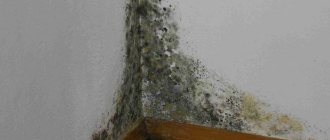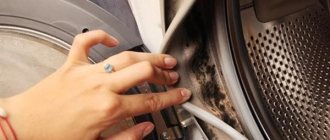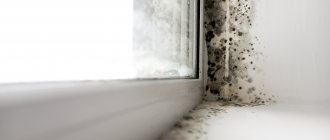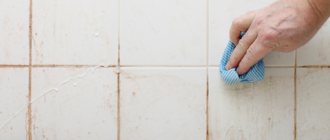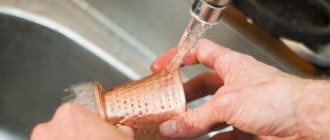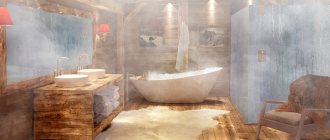Mold spores spoil any surface, worsening its appearance. But they also have a negative impact on human health. Therefore, when signs of fungal development appear, it is necessary to begin an active fight against it. In addition to special means, there are folk remedies that can solve this problem, including copper sulfate. But it is recommended to use it carefully. Therefore, it is worth figuring out how to use copper sulfate against mold.
What is vitriol and how does it happen?
In addition to copper sulfate, there are other types of vitriol. However, copper sulfate is used to eliminate fungal spores. It represents crystalline hydrates of sulfates. Actively involved in medicine, agriculture, and construction. Externally, vitriol resembles small crystals with a blue tint.
Copper sulfate is used to eliminate fungal spores.
What properties does copper sulfate have?
It was noted that copper sulfate is used in medicine, as well as in the agricultural sector. However, it also found use in everyday life. It is often used to remove traces of mold. Suitable even for wood. Copper sulfate can also remove traces of rust. Can be used to prevent the formation of fungus. Among the key properties of the substance are antiseptic.
Copper sulfate can be used to prevent the formation of fungus.
What does the substance look like?
Copper sulfate, copper sulfur salt, copper sulfate are all names for the CuSO4 compound with a characteristic bluish color. Among other types of vitriol, this substance is widely used in the agro-industry, agriculture, construction, medicine, and everyday life.
It looks like a blue crystalline powder, colorless and odorless, easily distinguishable from other bulk compounds.
Causes of mold and mildew on walls
Mold can actively spread over the surface. If the necessary measures are not taken to solve the problem, the health of a person living in such conditions may worsen, even to the development of bronchial asthma. But the fungus does not begin to actively develop in all rooms. Favorable conditions are important for him. One of the common causes of mold development is a humid environment. In rooms with high air humidity, spores multiply more actively, penetrating deeper into the surface layers, reliably attaching themselves there.
A humid environment occurs due to constant temperature changes, regular freezing of the room, and wetness of various surfaces. The lack of a quality ventilation system only exacerbates the problem. Therefore, fungus can appear for the following reasons:
- Severe dampness in the room;
- Lack of good ventilation;
- Some parts of the room are not warm enough.
The apartment can be cozy and warm, but even if at least one corner gets wet or freezes, this is enough for mold to actively spread.
A common cause of mold development is a humid environment.
Surface cleaning
Carrying out any kind of work on the ceiling necessarily includes the stage of its cleaning and preparation. The only exception is a small leak - in this case, only the floor area can be treated.
If we are talking about a new apartment and the purpose of the renovation is to put it in order, then most likely, before painting or pasting, you will only need to clean and wet clean the ceiling. In other cases, the preliminary stage will take longer.
1. The room should be freed from furnishings as much as possible. Cover the floors, walls and remaining furniture with a blanket. It is recommended to carry out cleaning, like all other work, wearing long sleeves and a respirator - in extreme cases, you can use a gauze bandage, which should be changed periodically.
2. The old coating is removed. As a rule, to apply paint or whitewash it is enough to eliminate a layer of old finish. To do this, the surface is thoroughly moistened with warm water, and when the layer of old coating is well saturated with moisture, the latter is removed with a spatula.
For durable paint, warm water will not be enough. In this case, it is recommended to use a special paint solvent or use the “dry” method - remove the old layer with a sanding machine. The product is effective, but extremely dirty, producing a huge amount of fine, irritating dust, so it should be used with caution.
3. If the plaster peels off when removing a layer of whitewash or paint, you should remove the entire old plaster layer to the base. In case of small damaged areas, they can be cleaned without treating the entire surface. But if the plaster comes off in large pieces, then the entire ceiling should be cleaned. The plaster layer is removed with a spatula; in particularly difficult areas, more serious tools can be used, even a drill.
What can mold cause in your home?
It was noted that the presence of mold can adversely affect health. Spores have a negative effect on the human body for a long time.
Among the common problems that result from constant inhalation of fungus, it is worth noting:
- Development of allergies;
- Decreased general level of immunity;
- Migraine;
- Exacerbation of diseases associated with the lung and bronchial system;
- Development of respiratory diseases.
That is why it is necessary to immediately begin eliminating fungal spores. When primary signs of their presence appear in the house.
The presence of mold can adversely affect your health.
What vitriol should be used against mold and where to get it
Treatment with copper sulfate is usually carried out for mold problems. It is not used in its original form, but after mixing with water, becoming a solution. You can buy crystals in different packaging in stores that sell building materials, household supplies and gardening products.
It is not used in its original form, but after mixing with water, becoming a solution.
Where can I buy the product?
Vitriol is available, which determines its popularity in various industries. Copper sulfate powder can be purchased at gardening, hardware departments, fairs, and hardware stores. Packaging varies depending on the purpose of the product:
- small bags of copper sulfate 50-100 g can be found in gardening departments at a price of up to 50 rubles per piece;
- in construction stores and construction depots bags of larger weights are sold - up to 500 rubles for a volume of 0.5-1 kg.
Advantages and Disadvantages Compared to Other Mold Remedies
This remedy has been used for many years to eliminate fungal spores. This popularity is associated with a number of advantages, including:
- Good efficiency;
- Low cost of the method;
- Variety of product packaging. You can purchase it in a convenient quantity;
- Easy to use;
- Practicality;
- Protection against re-development of fungus.
One of the disadvantages of the product is that it should only be used in untreated cases. Vitriol will not cope with old, deep traces of mold. It is also necessary to use protective equipment when working with this product, otherwise you may get poisoned.
It is imperative to use protective equipment when working with this product, otherwise you may get poisoned.
Tools and materials
To treat the walls, ceiling and floor of the bathroom with an antiseptic (specially designed anti-mold or other aggressive compounds) you will need:
- container for diluting the product;
- spray/brush/brush;
- protective equipment (respirator, rubber gloves, safety glasses);
- sponges and rags.
If there is deep damage to the walls and ceiling, it is advisable to remove all the finishing, including the old tiles (otherwise the mycelium will remain under the tiles) and thoroughly dry the building structures. In this case, you need to stock up:
- a hammer drill with a chisel or a chisel with a hammer (for dismantling tiles);
- metal spatulas;
- construction hair dryer (for effective drying of structures).
What surfaces can it be used on?
A feature of the product is its versatility. It is suitable for various surfaces, including wood, concrete, brick, stone. You can also process drywall and gypsum fiber.
Do not use copper sulfate on metal parts or surfaces. This may trigger a chemical reaction.
Do not use copper sulfate on metal parts or surfaces.
Instructions for use
When purchasing copper sulfate, it comes with instructions regarding the nuances of its use. The information should be carefully studied and the recommendations provided should be strictly followed.
To treat with vitriol, you need to prepare a special solution. Use a container made of plastic, glass or ceramics in which you do not plan to cook food later. The solution is diluted in proportions of 1:100, where for 10 liters of water you need to take 100 g of vitriol crystals. If the fungal infection is not initial, but more severe, it is worth preparing a more concentrated product. Then the proportions change and the ratio becomes 3:100.
First, add a little preheated water to the prepared amount of copper sulfate. Mix everything with a spatula and strain. Then add the rest of the liquid.
If the fungal infection is not initial, but more severe, it is worth preparing a more concentrated product.
Using vitriol as a fertilizer
This chemical contains copper, which is a valuable microelement for plants. Its deficiency is manifested by yellowing of leaves, loss of brightness of flowers, and falling of young shoots. It is necessary to dissolve 5–10 g of vitriol in a bucket of water, then use the product for foliar feeding of tomatoes, cabbage, and potatoes.
Copper sulfate is a cheap but very useful fertilizer and a high-quality antiseptic. It can be used without fear, but in compliance with technology, proportions and protective measures - then the result will be excellent.
What you need to remove mold using vitriol
Before you begin the troubleshooting process, you need to prepare everything you need in advance. This will allow you not to forget anything and approach the matter in a more organized manner.
To deal with mold, you need to prepare the following:
- Ready solution. It is enough to mix all the ingredients in one suitable container. To increase efficiency, it is recommended to add about 200 ml of vinegar per 10 liters of water to the finished composition;
- Tools with which the product will be applied to the surface. A spray bottle will do. It is the most convenient for such a process. But you can also use a brush or sponge;
- A spatula and a metal brush, allowing you to clean the affected areas;
- Means for protecting the body. In addition to clothing that covers all parts of the body, you need to equip yourself with gloves and a mask.
When these items are prepared, the process of eliminating the fungus problem begins.
Before you begin the troubleshooting process, you need to prepare everything you need in advance.
Consumption rates
As a rule, a 1% solution is used with a consumption rate of about 10 liters per 100 m2. To prepare the working fluid, dissolve 100 g of copper sulfate in 10 liters of water or 10 g per 1 liter of water.
General rules for diluting copper sulfate:
- Apple, pear, quince: for scab, phyllosticosis and other spots, moniliosis, drying out 100 g of the drug per 10 liters of water, first spraying in early spring before buds open, at a consumption of 2-5 liters per tree. Can be repeated 2 weeks before harvesting apples and pears.
- Apricot, peach, plum, sweet cherry, sour cherry: against clasterosporosis, coccomycosis and other spots, moniliosis, leaf curl, dilute 50-75 g per 10 liters of water, first spraying in early spring before buds open, at a consumption of 2-3 liters per tree .
- Gooseberries, currants: for anthracnose, septoria and other spots, dilute 50-75 g per 10 liters of water, first spraying in early spring before buds open, with a consumption of 1.5 liters for an average-sized bush.
- Spraying potato tubers against late blight before planting: 2 g of the drug per 10 liters of water. It is more convenient to put the planting material in a vegetable net and dip it in the prepared solution.
- Indoor flowers - watering against a complex of diseases - dilute a teaspoon (without a slide) in 2 liters of water to get a sky-blue solution, water at the root or spray on the leaves.
For spots on vegetables, for example with ascochyta blight on cucumbers, plants can be sprayed with a 0.5% solution of copper sulfate and urea: 5 g of vitriol and 10 g of urea per 10 liters of water, repeat twice at weekly intervals.
To disinfect open ground soil and greenhouses from diseases a week before planting seedlings or sowing seeds, water the soil with a 3% solution of copper sulfate (30 grams per liter of water). Such treatment will also protect potatoes from late blight.
To treat the root system before planting, dilute 100 g of the drug in 10 liters of water, soak the root system (bulbs or tubers) for 3 minutes. Then remove from the solution and rinse thoroughly in running water. Bulbs or fleshy tuberous roots, then air dry before planting.
How to dilute copper sulfate
Dilute the required volume of powder, for example, 100 g of copper sulfate, in a small amount of water (500-700 ml), poured into a plastic bucket and heated to a temperature of 40-50 degrees (dissolution is better), add water while stirring to increase the volume of the working solution up to 10 l. Do not use metal utensils! Before pouring the prepared solution into the sprayer, strain through a filter, for example, through nylon tights.
Treatment of tomatoes with copper sulfate against late blight
Tomatoes are plants sensitive to errors in treatment with copper-containing preparations. In order not to burn the leaves, but to defeat late blight, a very weak concentration is enough, only 0.2% solution. Prepare a copper-soap emulsion: grate 200 g of laundry soap and dilute it in a small amount of hot water; separately in a glass jar, dilute 20 g of copper sulfate, use a wooden stick to stir, pour the fungicide into the soap solution in a thin stream, stirring constantly and bring the solution to 10 liters of water.
You need to spray the tomatoes with this solution over the leaves, the scheme is as follows:
- spray the seedlings for the first time, a week after planting in a greenhouse or open ground
- further, depending on the weather, if the summer is dry and there is little rain, then do not spray until the August cold snap, make do with preventive treatments with phytosporin, if the summer is damp and cool, treat every 10-12 days.
Spray in calm weather, trying to wet the back of the leaves.
When can you eat fruits and vegetables after spraying with copper sulfate?
Most vegetables can be eaten 14-15 days after spraying, with the exception of:
- melons (cucumbers, zucchini, pumpkins, watermelons, melons) - they can be sprayed 5 days before harvesting
- tomatoes can be sprayed against late blight and other diseases 7-8 days before harvesting tomatoes
Important: rinse all fruits thoroughly with running water several times - copper is not absorbed by the plant and does not penetrate into the fruit, it remains on top of the fruit shell and is dangerous only if the fruits have a soft skin, such as peaches, or the fruits are cracked.
Fruits and berries that cannot be washed well before eating - raspberries, strawberries, apricots, peaches, grapes, some varieties of currants (with soft berries) - can be sprayed with copper preparations at least 1.5 months before the harvest ripens: one treatment before flowering, and the second by ovary.
Copper sulfate for root rot, blackleg, fusarium
To save cucumbers, zucchini or pumpkins from root rot (symptoms: wilting of bushes in hot weather, yellowing of leaves, dying off of ovaries, stopping the growth of greens), you can prepare the following solution: 1 teaspoon of copper sulfate, 1 teaspoon of zinc sulfate, 1 tbsp. . a spoonful of simple superphosphate per 10 liters of water. Water the cucumber bushes with a freshly prepared solution at the rate of 5 liters of liquid per 1 square meter. m of land.
Watering against blackleg and fusarium of vegetables and flowers: dilute 5 g of the drug per 10 liters of water.
How to treat wooden structures with copper sulfate
Copper sulfate is an excellent antiseptic; it can be used to treat any wooden structures in a summer cottage - the walls of greenhouses and hotbeds, walls and structures of cellars, sheds, gazebos, wooden flooring, fences. It is better to apply the solution by spraying, on small surfaces with a brush or sponge (work with gloves). Let dry and repeat the treatment two more times. The coating must be renewed after 3-4 months.
In some cases, for longer protection time, you can add clay to the solution to create a creamy mass; use it to coat the supporting posts of a fence, the porch of a country house, or support beams in greenhouses.
You need to know that deeply ingrained mold cannot be removed or destroyed with copper sulfate; it is better not to use such material, since the boards lose their strength, and mold from them can spread to neighboring ones; in such cases, it is worth using preservative, non-washable antiseptics.
Copper sulfate as fertilizer
Copper sulfate is applied only on soils poor in this element, for example, chernozems contain copper in sufficient quantities, a little less, but not fundamentally, in sod-podzolic and gray forest soils, but peat-bog and in some places sandy and sandy loam soils contain little copper, therefore Once every 5-6 years, in early spring or autumn, you can add copper sulfate: consumption 1 g per 1 sq.m.
For foliar feeding of vegetative plants with signs of copper deficiency (manifested primarily on young leaves), the dosage is 1-2 g of copper sulfate per 10 liters of water.
Preparing walls for processing
The fight against fungus begins with surface preparation. This will speed up the process and increase its efficiency. First, you should ensure maximum ventilation in the room. To do this, turn on the hood and open the windows as much as possible. Surfaces affected by spores are freed from covering, wallpaper is removed, paint and plaster are cleaned. If the fungus has managed to penetrate deeply inside, then you should additionally clean the areas with sandpaper.
Treat problem areas with a soap solution and leave to dry completely. This stage should not be neglected, especially if black mold has begun to develop. Finally, you must put on the prepared personal protective equipment.
If the fungus has managed to penetrate deeply inside, then you should additionally clean the areas with sandpaper.
putty
It is used for cases when it is necessary to level the ceiling, for example, for painting. It should be noted that with this help you can level out quite large defects - level differences, cracks, holes, seams, voids, and so on. For difficult cases, when the plaster layer reaches 3–5 cm, it is necessary to use a painting mesh to ensure the strength of the finishing coating.
1. Prepare a starting putty - the consistency of thick sour cream. The composition is collected with a narrow spatula, applied evenly onto a wide spatula - 450 mm, and then placed on the ceiling.
2. The putty is applied in strips, usually from the window. Apply as evenly as possible.
3. Before painting, the ceiling should be as level as possible. The easiest way to achieve this is to use a paint mesh. It is cut into strips of the appropriate size - according to the width of the strip, and embedded in a freshly applied layer of putty. After drying - about 8 minutes, the strip is puttied a second time with a thin layer - up to 3 mm.
4. It is recommended to proceed as follows: cut a fragment of the mesh narrower than the strip of plaster layer by 5 cm. Apply a second strip of putty nearby, and position the second piece of mesh so that it overlaps the remaining 5 cm of the first. Thus, the joints of the serpyanka and the putty strips will not coincide, which means it will be easier to achieve a flat surface.
5. The starting putty dries completely within 24 hours. If necessary, you can sand the surface with sandpaper or mesh.
6. The finishing putty is prepared more liquid and is applied in wide layers. After partial drying, the layer is sanded with mesh or sandpaper.
7. The second one is overlapped and also sanded. If the ceiling is being prepared for glossy paint, it is recommended to apply a layer of acrylic putty.
8. After complete drying, the ceiling surface is sanded; it is recommended to carry out the procedure in a darkened room and illuminate the ceiling with a flashlight, since in such lighting it is easy to notice all the defects. Then a primer is applied before painting.
Treatment and application
When the surface is prepared, you should start applying vitriol. If you use a spray bottle, just spray the solution onto the desired area. You can apply the product with a sponge, wetting it in the composition and wiping the desired area. Processing should be plentiful. After 4-5 hours, when the surface has dried, it is worth repeating the procedure. The solution is applied again.
The number of repeated treatments after the composition has dried depends on the degree of fungal development. If there is a lot of mold and it has become embedded in the surface, then you will have to repeat the procedure many times. On average, the number of repeated treatments is reduced to 2-5 pieces.
If the spore damage is serious, then in addition to removing the cladding, you must first completely clean off the plaster. Only after this can you begin to treat the area with the solution.
If you use a spray bottle, just spray the solution onto the desired area.
Ceiling surface primer
Regardless of further actions, the ceiling should be primed. The process has two goals: to strengthen the surface and level it - since the polymer base of the primer impregnates and tightens micro defects, and to provide better adhesion - with putty, paint or whitewash. At the same time, the primer helps reduce paint costs - there is no need to repeat the painting procedure many times.
• For ordinary cases, a deeply penetrating primer is used - it significantly increases the degree of adhesion. Apply at least two coats in opposite directions. The second layer is applied only after the first has completely dried.
• The tool used is a regular cloth roller with a long handle. In corners, cracks, and rustications, it is advisable to use a brush to ensure truly deep treatment.
The role of the primer does not end there.
What can you mix with?
In order to increase the effect, some other ingredients are added to the finished composition. This could be 200 ml of vinegar, which will have a positive effect on the processing result. It is also permissible to mix copper sulfate with a few drops of tea tree oil or a small amount of detergent that contains chlorine.
The connection cannot be made with other substances. An undesirable reaction may occur. Also, the prepared solution can be stored for about 3 months on the shelf. If you place the container in the refrigerator, you can preserve the composition for a year. It is important to ensure that the lid is well closed and the solution is in a place that is difficult to reach for children and animals.
To increase the effect, add 200 ml of vinegar, which will positively affect the result of the treatment.
Properties and Application
Copper sulfate is widely used as a fungicide and antiseptic, popular in the following areas:
- crop production As a fertilizer and anti-fungal agent. The main component in the so-called Bordeaux mixture for the treatment of cultivated plantings;
- construction. Copper sulfate is used against mold on wood and for treating plastered and concrete walls. It is effective in removing rust stains and salt deposits on brick and stone walls;
- mechanical engineering. Used to indicate impurities in stainless steel and aluminum alloys, remove rust and metal processing.
It is known in industry as a food additive and preservative, a constituent substance in the production of paints and varnishes.
Interesting fact ! Copper sulfate is used for chemical treatment of reservoirs with standing water in order to prevent the proliferation of phytoplankton and, as a result, its bloom.
How long does the result last?
The duration of the result depends on many conditions. It is important not only to treat the surface, but also to organize everything in such a way as to prevent the fungus from re-developing. It is necessary to exclude high humidity, lack of ventilation and freezing, wetting of surfaces. Then the result from the process will last a long time. If favorable conditions for the spread of spores reappear, then such treatment will have to be repeated constantly. The result will not be long-term.
It is necessary to exclude high humidity, lack of ventilation and freezing, wetting of surfaces.
Industrial processing of wood material
Processing wood with copper sulfate in industry involves the use of professional equipment. The wood goes through a whole series of events, starting with drying the wood, loading the dried material into an autoclave, and soaking itself in a vitriol solution. The substance penetrates into the deepest wood fibers thanks to a maintained temperature of +40 ° C and a constant pressure of 10 atmospheres. Artificially created conditions make it possible to spend only 30 minutes on the soaking process, after which the wood is removed and sent for drying. It is not possible to recreate this technology at home.
Preventive measures
In order for the treatment to give the desired result, preventive measures must be taken. This will reduce the likelihood of the fungus developing again and prolong the positive effect of vitriol.
There are a number of measures that will allow you to forget about the problem of mold spread. Among them:
- Regular ventilation of the room. This applies even to the winter period;
- Providing good ventilation;
- Avoiding hypothermia of walls;
- Make sure that the increase in humidity in the room does not last long;
- Monitoring the condition of plumbing. It must always be in good working order;
- Regular and careful maintenance of the water supply system;
- When carrying out repairs, it is necessary to use materials whose compositions are resistant to moisture. It is also recommended to use antiseptics;
- When arranging furniture, leave a small distance between objects and windy walls. Then the air will circulate without obstacles, freely;
- In rooms with significant levels of humidity, it is worth limiting the number of flowers to a minimum.
If the room has plastic windows, then you should take care of high-quality ventilation. Especially if the cladding is made of tiles or plastic panels.
When arranging furniture, leave a small distance between objects and windy walls.
Safety precautions at work
In pursuit of getting rid of a fungal problem, it is important to remember your own safety. Therefore, it is necessary to carefully follow all recommendations so as not to harm the body when treating the affected areas.
Among the basic safety rules it is worth noting:
- Gloves must be worn at the stage of preparing the solution, when the crystals are mixed with water. Not only rubber products are suitable, but also latex ones;
- The airways need protection. A respirator would be ideal. But if you don’t have it at hand, you definitely need to put on a gauze bandage and make an improvised mask from it;
- Eyes also need protection. That’s why it’s worth arming yourself with plastic glasses;
- It is not necessary to use special protective overalls. Regular clothing will do. The main thing is that it tightly covers all areas of the body completely. After use, it must be washed;
- All windows and doors must be opened when working. You should also open the windows and turn on the ventilation;
- Animals must be removed from the room and children taken away.
Following these rules will allow you to avoid poisoning and maximize your health while working.
In pursuit of getting rid of a fungal problem, it is important to remember your own safety.
Safety rules: important requirements
Basic safety measures when treating walls with copper sulfate:
- During processing, hands should be protected with rubber gloves;
- wear protective goggles over your eyes to protect them from splashes of the solution;
- the nasopharynx should be protected with a respirator;
- During processing, the ventilation in the room should be good, and the windows should also be opened;
- After treatment, clothes are washed and hung to dry on the balcony.
Is vitriol dangerous, and what are the symptoms of poisoning?
Vitriol is classified as hazard class 3. That is why it is so important to take procedures using it seriously. You should not neglect safety measures. Poisoning may occur. It is important to recognize illness quickly and early. With the negative impact of vitriol on the body, nausea and vomiting occur. The heartbeat quickens, severe weakness appears. Pain in the stomach area may also occur. Pain sensations are affected by the degree of poisoning. It can be mild, aching or sharp and sharp.
The most dangerous symptoms are an allergic reaction and toxic shock. It is important to call for help in time and consult a doctor. Any contact with vitriol should be stopped as soon as the first signs of poisoning appear.
Any contact with vitriol should be stopped as soon as the first signs of poisoning appear.
Copper sulfate has long been used to combat fungal spores. And it has proven its effectiveness. He will not be able to cope with a serious, long-standing fungus alone. But not in severe cases, it is quite suitable for solving the problem. The main thing is to protect the body from the negative effects of the product so that the process is not only effective, but also safe.
Danger of mold
Mold is a colony of microscopic fungi. It can appear on any wet surfaces. The most favorable environment for it is porous and rough surfaces: concrete, plaster, wood. Black mold is most often found in apartments. During its life, the fungus releases toxins that are dangerous to human health. Entering the body of spores and biological poisons can cause allergic reactions, bronchitis, asthma and other serious diseases.
The effects of mold on wood structures are similar to rot. Under its influence, the material is destroyed. The strength and service life of buildings is reduced. Toxins also affect polymer materials, plastic panels, and rubber seals. Rust appears on metal structures under stains of mold. In cellars, the fungus and the poisons it produces are the cause of food spoilage and poisoning.

